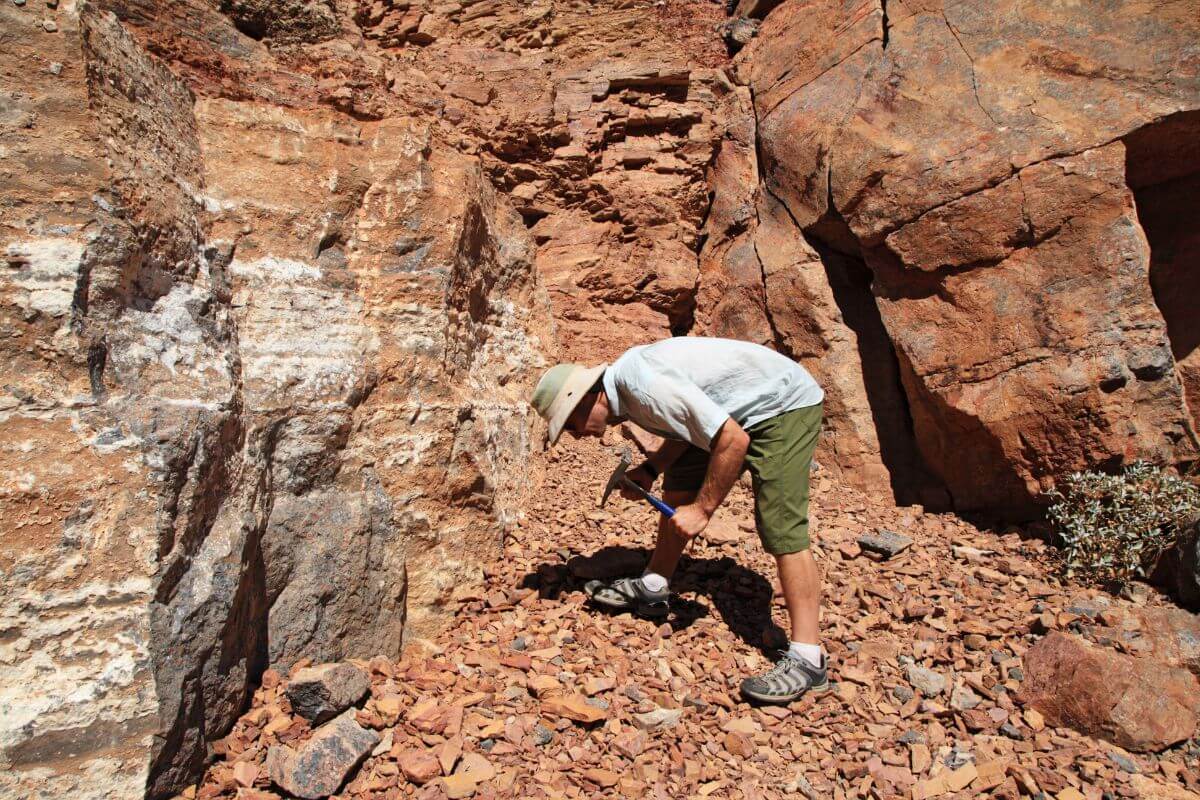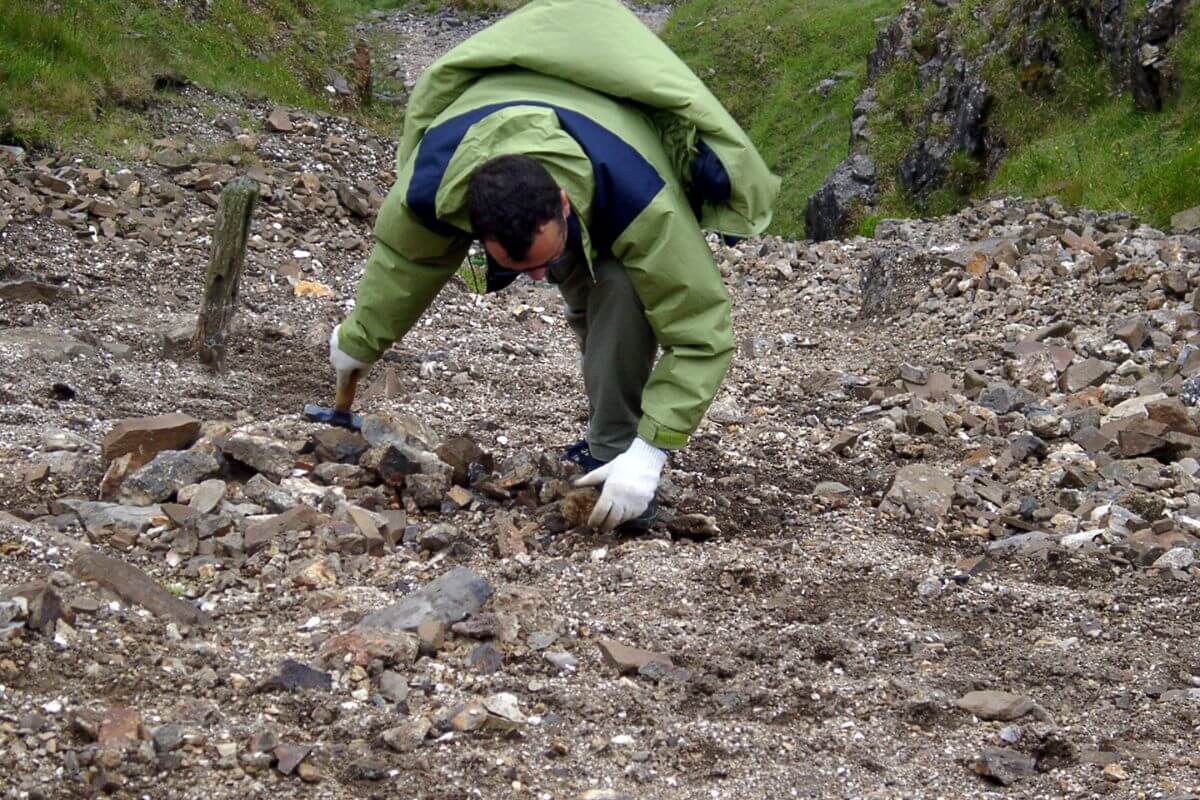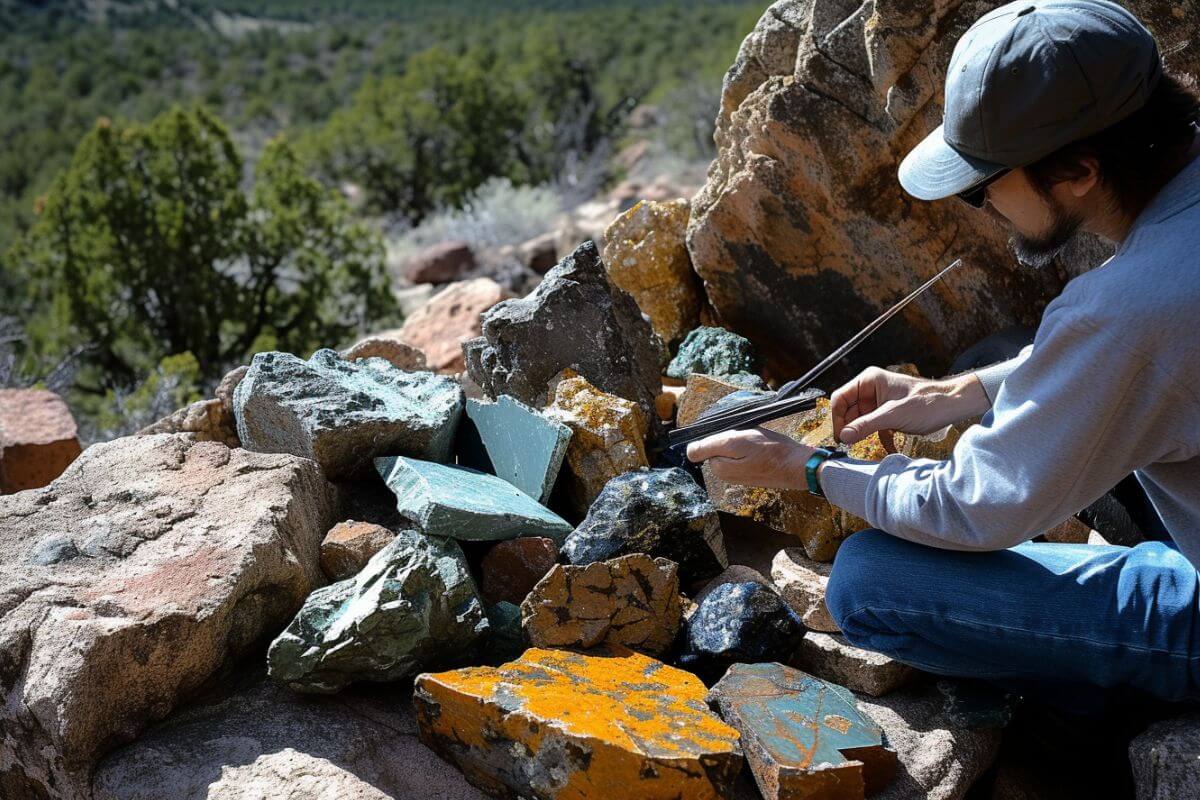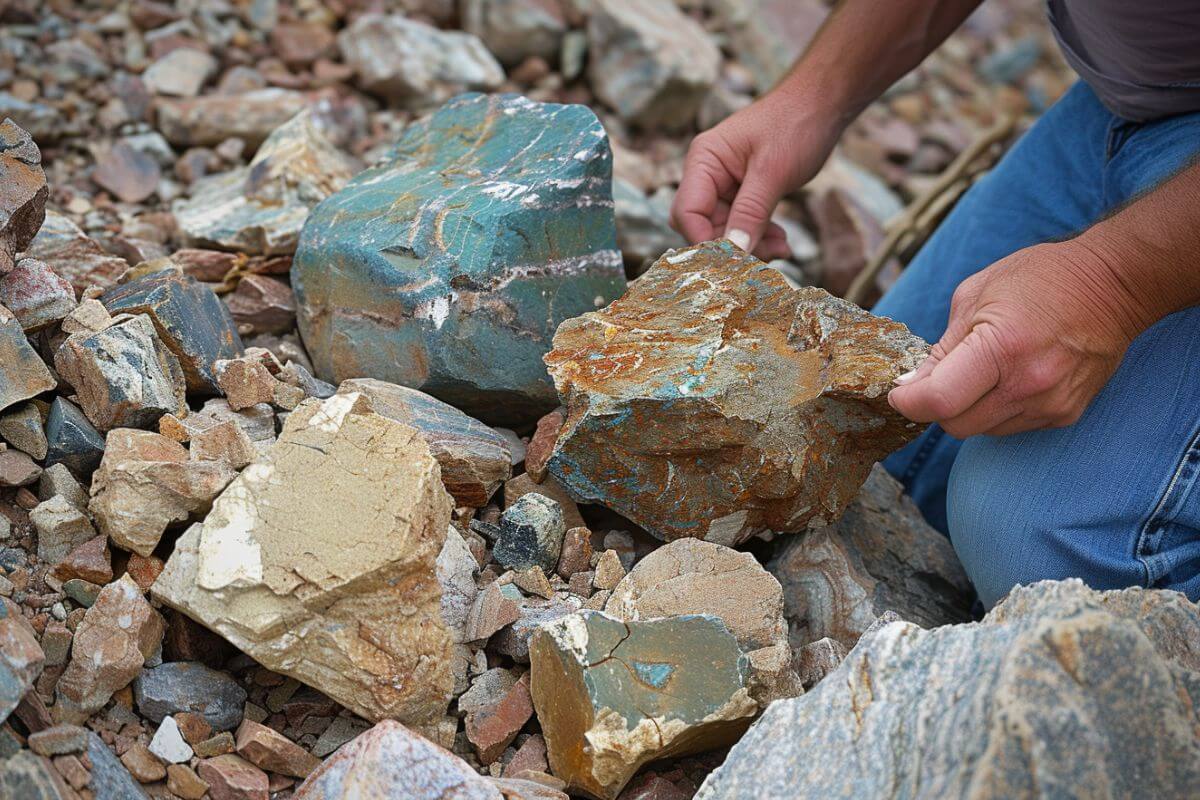Are you fascinated by the idea of unearthing rare, sparkling treasures nestled beneath the earth of the Treasure State? Home to some of the most enchanting geological features in North America, Montana offers a rockhounding playground that’s not to be missed.
The state’s rocky terrain, formed by volcanic activity in the west, is renowned among geologists and hobbyists alike. Once a leading producer of gold and precious metals, this land still holds hidden fortunes in its hills, valleys, and rivers.
From the diverse array of crystals at the world-famous Crystal Park to the opportunity for gemstone mining in the Treasure State at Gem Mountain Sapphire Mine; and from the fascinating petrified forest at the Gallatin National Forest to the wealth of minerals along the Jefferson River – our guide is your ticket to unlocking this Montana wonderland.
In this article, we’ll cover the best rockhounding sites in Montana as well as provide tips and tools to ensure an enriching and successful experience. From the proper gear to valuable rockhounding tips, this guide has got all your expedition essentials covered.
- Related article: Montana Gems
Get ready to dive deep into the geologic narrative of Montana, and come out with your pockets full of natural wonders.
7 Key Takeaways on Montana Rockhounding Sites
- Montana is home to a diverse range of rockhounding sites, including the pristine rivers – Jefferson and Yellowstone Rivers.
- Calvert Hill Mine is an abandoned tungsten mine near Wise River that’s now a hotspot for rare crystals like aquamarine and garnets.
- Crystal Park is a 220-acre site along the Pioneer Scenic Byway offering open season crystal digs with various quartz formations.
- Known for its upright petrified trees, Gallatin National Forest offers a fascinating rockhounding experience.
- Featuring agates and jasper, Jefferson River is a journey through Montana’s ancient geology.
- Experience a real mining escapade with sapphires in various hues and family-friendly sifting options in Gem Mountain Sapphire Mine.
- Hunt for geodes in Bear Canyon, Pryor Mountains – a scenic wonderland with geodes typically lined with sparkling drusy quartz.
- Ruby Reservoir is ideal for finding garnets when the water level is low, a magnetic helps differentiate them from rubies.
Best Montana Rockhounding Sites

Have you ever wondered how the rugged landscapes of Montana might hold within them glittering treasure troves of gemstones and minerals? The state offers an incredible rockhounding adventure, with a myriad of sites that showcase Mother Nature’s artistry.
From former mining sites like Calvert Hill offering unexpected treasures to the diverse Crystal Park, Montana’s natural beauty and geological history come together to offer an engaging and informative rockhounding adventure.
1. Calvert Hill Mine
Just a stone’s throw (pun intended) from Wise River, specifically about 6 miles (9.7 km) west, lies the Calvert Hill Mine. Historically known for tungsten extraction, this mine today has rockhounds flocking to its tailings and nearby ponds for a different kind of treasure hunt.
If you’re hunting for rare cool specimens like epidote, aquamarine, scheelite, or garnets, Calvert Hill Mine won’t disappoint. “I’d read about the small green crystals embedded in bigger rocks, and I was thrilled to find them exactly where they were said to be,” shared one enthusiastic rockhound I met on my last visit.
The mine itself is no longer in operation, but the rocky legacy it left behind is a delight for rockhounds of all experience levels. When you spot a large blue pond as you explore, which is hard to miss, you’ve struck “gold” in terms of where to focus your search. These mine tailings, particularly those on the left, are not only generous but also yield some of the most sought-after cool specimens.
The Calvert Hill Mine stands as a lesson in how something intended for one purpose, like tungsten mining, can morph into an unexpected haven of beauty for those who appreciate the Earth’s natural treasures. So, if you fancy a break from the everyday tourist spots, don your hat as an amateur geologist, and explore what Calvert Hill has to offer beneath the surface.
2. Crystal Park
Crystal Park is one of those rare perks we rationalize while navigating the well-trodden journey to find amethyst and quartz in Montana. It’s nestled on the Pioneer Scenic Byway south of Wise River, a location so breathtaking it feels like you’re rockhounding in a painting.
But it’s not just about the scenery in Crystal Park; on this 220-acre site, crystals are more liberally dispersed than wisdom at a commencement speech. “I’ve found a variety of quartz here — smoky, clear, in scepter form, you name it,” says avid rockhounder, Emily.
Key Things When Visiting Crystal Park:
- Open seasonally from mid-June through mid-October
- $5 per person/day fee
This popularity doesn’t imply overrunness (if that’s not a word, it should be); thanks to the area’s many pockets of crystals, there’s usually something to be uncovered from clear, cloudy, white, gray, or purple.
It’s okay to get excited about the great finds, but managing expectations is as crucial as carrying a sturdy shovel. Most crystals are judged more for their collector’s value than their market worth. You wouldn’t mistake Crystal Park for a diamond mine, but for rockhounding enthusiasts, it’s a jewel in Southwest Montana’s treasure chest.
3. Gallatin National Forest
Gallatin National Forest, one of the crown jewels of Montana, not only showcases stunning landscapes but is also a fascination for rockhounds. The Tom Miner Basin, nestled within the forest’s expanse, houses what is known as the Gallatin Petrified Forest, a geological gem just waiting to be discovered.
While the Gallatin Petrified Forest is the star here, it’s worth mentioning that the surrounding mountains and streams also hold their secrets in the form of crystallized and agatized petrified wood. In these hills, there is something for everyone, whether you are a seasoned rockhound or an amateur collector.
To start your petrified wood collection jaunt, you’ll need a permit. But wait, don’t fret — it’s not the sort of bureaucratic ordeal you’d find in a city hall. These permits, readily available for free at the ranger stations in Bozeman, Livingston, and Gardiner, are just a way of saying ‘respect the land you’re on.’
Gallatin Petrified Forest is like a time capsule, and each visit is a journey into Montana’s vibrant geological past. So, whether drawn by science or just the raw beauty of the petrified wood scattered across the landscape, Gallatin National Forest is a must-visit for any rockhound traversing Montana’s stunning terrain.
4. Jefferson River
The Jefferson River, a fantastic rockhounding location, is like an old, trusted friend who always has something exciting up its sleeve. Sure, it might not boast the widespread notoriety of the Missouri or Yellowstone, but trust me, the Jefferson quietly holds rich geological secrets that are just waiting to be discovered.
Jefferson River, over eons, has not only carved out its place in the Montana landscape, but it has transported a treasure trove of agates, chalcedony, and jasper across the terrain. So when you’re out scouring the riverbanks, be sure to keep an eye out for these mesmerizing gems.
You see, the geology of the Jefferson River and the surrounding mountain ranges is nothing short of a geological marvel. Think back, way back, to the Archean Eon, about 2.7 billion years ago — yes, that’s how old we’re talking.
The layered feldspars, glistening gneiss, glassy quartz, heavy dark amphibolite, and sometimes even marble, are a testament to this ancient era. It’s like peeling back layers of Montana’s past, and it’s utterly fascinating.
Rockhounding along Jefferson River isn’t just about the act of finding; it’s a journey through time and nature, a personal peek into the ever-evolving story of our planet. With a good dose of luck and a respectful approach, you might end up unearthing treasures that will leave you mesmerized.
5. Gem Mountain Sapphire Mine
Gem Mountain Sapphire Mine, a true playground for rockhounds, sits about 22 miles (35.4 km) west of Philipsburg on Montana’s Highway 38. These are not your average sapphires; Gem Mountain boasts one of the world’s largest sapphire deposits.
The experience at Gem Mountain is as authentic as it gets. You’ll get to sift through gravel at an actual mine, not just a curated exhibit. It’s like panning for gold in an old Western movie, except your treasure is even more fascinating: sapphires in an array of hues, from the classic deep blue to pretty pinks.
If you’ve always wanted to channel your inner prospector, Gem Mountain Sapphire Mine is the perfect spot. After your mining escapade, you can choose to own a piece of the experience, quite literally, by selecting a rough sapphire to have finished and set into jewelry for a one-of-a-kind keepsake.
It’s worth noting that Gem Mountain Sapphire Mine is a fantastic family-friendly destination. There’s no need to worry about the youngsters; they’ll be completely absorbed in the thrill of discovering age-old gemstones.
6. Pryor Mountains
Heading south of Billings, you’ve hit the geographic jackpot, the Pryor Mountains. This region is more than just a scenic wonderland; it’s a revered spot for those who like a touch of crystal in their lives.
Reports of geodes found in these parts might have even a non-rockhound salivating. Bear Canyon is where the action’s at. Expert geologists will say, “This is the best geode hunting spot in Montana, bar none.”
Bear Canyon is like the Willy Wonka golden ticket for rockhounds. You’re hunting for geodes that are typically lined with sparkling drusy quartz and rimmed with black and white fortification agate.
If you visit during spring or fall when temperatures are mild and the mud has receded, your Pryor Mountain rockhounding adventure will have all the elements of an outdoor thriller. You’re walking on ground that, quite literally, holds the fruits of the Earth.
7. Ruby Reservoir
If you’ve been intrigued by rubies and garnets, then Ruby Reservoir is a must-visit gemstone-enthusiast haven. Located south of Alder near Virginia City, this site stands out as a desert oasis in the world of rockhounding, offering a surprising variety of finds including calcite, opalite, and of course, the sparkling allure of garnets.
What You Need to Know When Rockhounding in Ruby Reservoir:
- Best Time for a Visit – Early spring and fall, but summer in particular, are the best seasons to explore Ruby Reservoir as the water level typically recedes, revealing more ground for your treasure hunt.
- Use Mesh Screen – A small mesh screen is indispensable for separating the smaller garnet pieces from the sand.
- Walk Toward the Sun – For a leisurely and magical experience, walk towards the sun, carefully scanning the top layer of sand. If timed right, you might just catch a gleam of cranberry light – a mesmerizing garnet in the rough.
This sleepy little Reservoir has been a sleeping giant in the community of destinations for rock collectors. So armed with your trusty mesh screen and a keen eye, you may find yourself leaving the shores of Ruby Reservoir with hands as rich as its namesake.
8. Spokane Bar Sapphire Mine
One of my top rockhounding revelations in Montana was the Spokane Bar Sapphire Mine, just a stone’s throw away from Helena. This site offers a real treasure hunt: you can dig for a fee and the Gold Fever Rock Shop on-site will set you up with all your gear if you don’t have your own. How cool is that?
The sapphire finds here are particularly captivating, thanks to an exciting strike right along the twists and turns of the Missouri River. Head to this gravel bar and you might just strike colorful, gemstone-rich earth.
At the Spokane Bar Sapphire Mine, it’s not just about the sapphires. Although they are the primary sparklers, you can also add diamond, topaz, citrine, ruby, and garnets in a variety of hues to your collecting of rocks.
It’s like Mother Nature decided to host a surprise party, and all these gemstones were on the guest list. And of course, every color sapphire under the sun can be found here — from the signature Montana blues to beautiful pinks and yellows.
Simply put, the Spokane Bar Sapphire Mine offers the quintessential Montana rockhounding adventure, where you can take home a piece of the state’s dazzling geological history.
9. Strawberry Butte
Strawberry Butte is where the figurative strawberry of your rockhounding ambition meets the literal topaz shortcake of your dreams. Serendipity, topaz geodes, and a good ol’ 4-pound hammer are your best tools to ‘crack’ into this rich topaz site.
Strawberry Butte Rockhounding Quick Facts:
- Rockhound Gem – Pale yellow to sherry-colored topaz.
- Key tool – A 4-pound hammer to expose topaz.
- Additional tip – Start along the road and work your way up for the best finds.
- Locational Tidbit – Located about 10 miles (16 km) south of Helena.
- Access – Obtain the gate key from the ranger station near the Helena airport; it’s usually locked.
The main access road to the summit is typically gated, but don’t start spelling defeat just yet. A quick trip to the ranger station near Helena Airport will grant you access, literally. They’ll hand you a key and possibly a few words of encouragement.
And not to alarm you, but a 4-pound hammer is pretty much your pickaxe here. To release the topaz treasures hidden behind the rhyolite, you’ll need to gently tap portions of the gray and light-maroon banding.
Strawberry Butte is unique and awe-inspiring. It’s a hunt that’ll take you beyond a road paved with gravel to one lined with golden-brown gems.
10. Yellowstone River
The Yellowstone River, a winding beauty that lacks for nothing, is your next stop on the Montana rockhounding odyssey. It’s the most prominent river flowing through Southeast Montana where you can gather unique stones like the Montana Moss Agate.
This sweeping river is not just a pretty picture for your Instagram. It’s a veritable treasure trove for serious agate hunters. These are no ordinary agates; they are one-of-a-kind. The unique Montana Moss Agates can only be found here, along the banks and beds of the Yellowstone River and its tributaries.
Your timing is key; the best agate hunting adventure happens when the water level is low. Get ready to pack your bags for an early spring sojourn or a late fall escape. In the early spring when the ice is just beginning to melt, or in late fall when the water level is at its lowest point, your opportunities for uncovering these breathtaking agates multiply.
Yellowstone River isn’t just about finding agates though. Thousands of years of volcanic eruptions have dispersed a variety of beautiful stones all along its shores. What beautiful rocks you can find in Yellowstone River include:
- Jasper – A plentiful find on Yellowstone River’s shores.
- Petrified Wood – Also abundant, a testament to the passage of time.
- Quartz – Known in lesser supply but still a possible win.
- Montana Moss Agate – The Holy Grail of rocks here; rarer than rubies.
So, why is Yellowstone River a bucket list destination for many rock collectors? It’s a wonderland straight out of a fantasy book, thanks to the rich geological history in its surrounding regions. The volcanic eruptions have made a magical medley of rocks to tantalize your taste for the beautiful.
How to Do Rockhounding in Montana

It’s not just what you find that’s exciting; the journey of rockhounding in Montana is an adventure on its own. From sapphire-strewn pathways to the sparkle of garnets, the discoveries you make are bounded only by your eagerness to explore.
When you’re ready to unearth Montana’s treasures, here is a list of tools and tips to ensure your rockhounding excursion is as educational as it is enjoyable.
Tools and Gear for Rockhounding
Hunting for treasure beneath Montana’s big sky is more than just a hobby; it’s an immersive geological experience. But like any serious exploration, you’ll need the right gear. Here’s what I’d recommend you pack for your day rock hunt:
- Protective Gloves – I know firsthand how sharp those rocks can be! A good pair of gloves protects your hands from jagged edges and cuts.
- Small Shovel or Trowel – For the more delicate digs, a compact shovel or trowel is a must. You’ll want to gently excavate without causing damage to your precious findings.
- Containers – Think of these as your rock armor. Bring along bags or buckets to safely store your discoveries without them becoming, well, a pile of rubble in your backpack.
- Safety Glasses – I can’t stress enough how valuable these are. They protect your eyes from debris and sharp edges, ensuring your safety.
- Prismatic Hammer or Rock Pick – These aren’t just cool, they’re essential! A prismatic hammer or rock pick is what you use to break open rocks and reveal the hidden jewels inside.
- Chisel or Screwdriver – Useful for prying open cracks in rocks. Just like the detectives in old movies, we too uncover the mystery layer by layer.
- Magnifying Glass – To get a closer look at your latest find. A magnifying glass can be very handy for examining the intricate details of your rock specimens.
- Maps and Guides – These are your rockhounding bibles. Carry them to locate prime rockhounding sites. They’re also great for geeking out over the geological history of different areas.
If you’re a rookie rockhound, proper footwear, sunscreen, and a portable water bottle are also essential. Remember, while a day rock hunt might seem like a leisurely affair, you’ll want to be well-prepared. These tools aren’t just cool to look at; they’re your companions in unearthing Montana’s underground wonders.
Now go ahead, pack your rock hammer, hit the trail, and start your Montana rockhounding expedition. Your future collection is waiting to be discovered.
Tips for Rockhounding

Rockhounding is a treasure hunt from Mother Nature herself, but before you head out, here are some golden nuggets of advice:
- Respect Private Property – Always seek permission if you’re on private land; it’s simply good manners. Most rockhounding in Montana is done on public lands like Bureau of Land Management properties or National Forests.
- Research Regulations – Understand that the legalities of rock collecting differ from the Pryor Mountains to Gallatin National Forest. Familiarize yourself with local rules to stay within collection limits, gather permitted rocks, and adhere to seasonal restrictions.
- Know the Types of Gemstones – Different areas of Montana are known for different types of gemstones. A little geological knowledge can make your rockhounding adventure way more rewarding.
- Weather and Season – Let’s be real, you don’t want to be chipping away at stones in sub-zero temperatures or under a scorching sun. Check the weather and plan your trip for a season that suits you, but also, does justice to the locale.
- Safety First – Those stubborn rocks can be tough nuts to crack. Wear sturdy shoes, use safety goggles, and handle your tools with care.
- Respect Nature and Wildlife – You’re a guest in their home. Leave no trace behind,
- Be Patient & Persistent – As one local rockhound put it, “The rocks aren’t going anywhere, kid.” Patience is your ally here. Don’t be disheartened if you don’t find a dazzling agate the moment you arrive. Rome wasn’t built in a day, and a rockhound’s success may take a few trips.
- Join Clubs – The rockhounding community is tight-knit. By joining local clubs or online groups, you’ll gain valuable insights from experienced rockhounds.
But remember, the rockhounding Montana is as unique as the gems you hope to find. So, prepare, but also be open to whatever adventure comes your way. Let this adventure be your canvas and enjoy the journey!
Montana Rockhounding Final Thoughts

In these diverse landscapes, Montana holds a trove of geological treasures waiting to be discovered. What sets the state apart is the variety it offers to rockhounds, making it a paradise for amateur geologists and seasoned experts alike.
From the once-tungsten Calvert Hill Mine, now a haven for crystal collectors, to the Petrified Forest of Gallatin National Forest that offers a glimpse into the state’s ancient geological past, Montana’s rockhounding adventures promise to be rich and diverse.
With each adventure, everything from the thrill of discovery to the respect for Mother Nature is an opportunity to further understand and appreciate the intricate beauty hidden just below the surface.
So next time you’re in the Treasure State, don’t just admire the views from above; venture under the earth’s crust to experience the natural wonders and rich history that Montana’s rockhounding sites have to offer.
Montana Rockhounding FAQs
1. Where Is the Best Place to Rock Hunt in Montana?
Montana is renowned for its diverse geological formations, and one of the best places for rock hunting is the Montana Agate beds near Yellowstone River, where enthusiasts can find a variety of colorful agates and petrified wood.
2. What Rocks and Gems Are Found in Montana?
Montana, home to Glacier and Yellowstone National Parks, boasts a rich variety of rocks and gems, including Montana Agate, garnets, sapphires, petrified wood, jasper, and quartz crystals, with the state being particularly famous for its sapphire deposits.
3. Where Can I Find Montana Sapphires?
Montana sapphires can be found in various locations in the state, with the most notable deposits situated in the gravel bars along the Missouri River near Helena, particularly in the Yogo Gulch area, known for producing high-quality, vivid blue sapphires.
4. Where Can I Dig Montana Agate?
Montana Agate can be found in several locations across the state, but one popular spot for digging is the Yellowstone River area, particularly the gravel bars near the towns of Livingston and Big Timber, where enthusiasts can search for the distinctive banded and colorful agates.
5. How Do I Identify Montana Agates?
Montana Agates are typically identified by their distinctive banded patterns, often displaying a mix of translucent and opaque layers in various colors, including red, orange, yellow, and brown.
They can range from small pebbles to larger nodules, and their unique patterns and vibrant colors set them apart from other agates, making them recognizable to experienced collectors.
Dive deeper into the world of Montana below:


